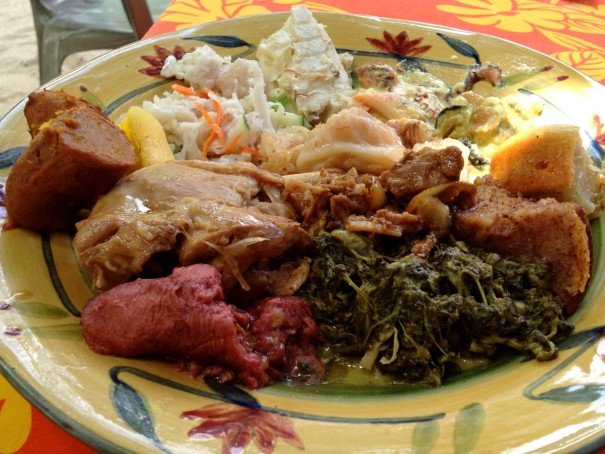
If You’d Like Seething Jealousy for Breakfast, This One’s for You

If You’d Like Seething Jealousy for Breakfast, This One’s for You
Ma’a Tahiti in French Polynesia
Four men in baggy surfers’ shorts drag a tarp from a smoldering underground pit the size of a double grave. They carefully peel off a layer of damp leaves and, after wrapping rags around their hands, lift up a slab of corrugated metal. Wielding a thick, wooden pole, one of the men digs into the pit and, using the pole as a lever, pries a blackened cage out of the earth.
Inside this smoking metal crate is our breakfast.
My husband Alan and I are on the island of Huahine in French Polynesia, waiting for the Sunday morning meal at Chez Tara. At this beachside eatery on the island’s southern tip, a leisurely hour’s drive from Fare, Huahine’s only real town, we’re going to dig into ma’a Tahiti, a traditional Polynesian feast cooked in an underground oven.
Every Sunday at 3 o’clock in the morning, staff at Chez Tara light the coals in the outdoor cooking pit. About an hour later, when the coals are hot, they begin layering other foods into the cage that serves as the underground grill. There’s pork and chicken. Several platter-sized whole fish. Taro, plantains, manioc, breadfruit, and papaya, all wrapped up in packets of green banana leaves.
At 11am, staff open the oven and begin unwrapping the foods, piling each item onto a bowl or platter. Inside the adjacent thatch-roofed restaurant, each dish is laid out on what quickly becomes a jam-packed buffet table, staffed by aunties wearing flowing dresses and colorful flower leis.
We start with an appetizer of poisson cru, the ceviche-like raw fish dish that’s ubiquitous across French Polynesia. As we line up and hold out our plates, each server dips her spoon into a bowl heaped with something stewy, meaty, or starchy, from stewed pork to a creamy spinach-like green that we learn is fafa, made from taro leaves.
We take our plates outside under the palm trees to the communal tables covered with flower-printed cloths and sit with our feet in the sand. We sip local Hinano beer, nibble our way through our breakfast, and chat with our tablemates in a mixture of French and English. Then we listen as two men settle into plastic chairs with their ukuleles and begin to strum and sing.
For dessert, we return to the buffet table for fresh fruit—mango, papaya, melon—and another Tahitian specialty, called po’e, which resembles a fruit pudding. Papaya or banana is roasted in banana leaves in the underground oven until it melts into a vividly colored goo. It’s dumped into a bowl filled with coconut milk, then stirred and pounded until the fruit begins to soften. The result is a sweet, sticky, almost caramelized fruit mash, glistening with coconut milk; a tropical comfort food.
Alan and I linger after our breakfast, as the sea laps onto the beach below. When your meal takes seven hours to roast in a hole in the ground on a remote South Pacific island, you feel like you should take your time to digest and appreciate it.
Besides, we’re thousands of miles from home and at least four or five hours from supper.